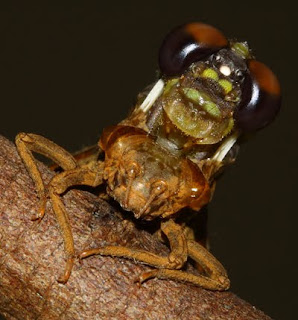
Over 250 species of odonates living in all kinds of aquatic habitats in Peninsular Malaysia. They are waiting for me to be explored........
Tuesday, August 31, 2010
Sunday, August 29, 2010
Paragomphus capricornis - Female
Paragomphus capricornis is a medium size gomphid species. I bumped into a female P. capricornis in Bangi Forest Reserve. The female and male P. capricornis have similar marking. Click here to see a male P. capricornis.


female Paragomphus capricornis


Saturday, August 28, 2010
Coeliccia octogesima - In Tandem
Male Coeliccia octogesima is more commonly spotted than female. To bump into a tandem pair of C. octogesima is something to be celebrated. I spotted a tandem pair of C. octogesima, and I waited for 20 minits to see if they would form a wheel pair before my eyes. However, they vanished before me, and I have to content myself with just tandem pair photos. The female C. octogesima has different thoracic marking than the male. Click here to see the clear thoracic marking of male C. ocotogesima.


Friday, August 27, 2010
Burmagomphus divaricatus - Female
Burmagomphus divaricatus is a medium size gomphid species occurring at muddy forest stream. I spotted a female of B. divaricatus at a small muddy stream in Bangi Forest Reserve. The male and female of B. divaricatus have similar yellow marking on thorax. Click here to see the male adult of B. divaricatus.


Female of Burmagomphus divaricatus


Microgomphus chelifer - Female
Microgomphus chelifer is a small gomphid species with a size of hw 20 mm. Well, its small size is well indicated by the name "micro" meaning small. I spotted a female of M. chelifer at a muddy small forest stream. I didn't expect to see M. chelifer at this type of habitat (the common habitat for this species is clear forest stream). The male and female of M. chelifer have similar yellow marking on thorax.

a female of Microgomphus chelifer

the characteristic side thoric marking of Microgomphus chelifer


Tuesday, August 24, 2010
Book - Dragonflies of Singapore
I received a complimentary copy of the book A Photographic Guide to the Dragonflies of Singapore. The book is authored by H.B. Tang, L.K. Wang and M. Hamalainen, and published by National University of Singapore. It is really an excellent book with excellent photos. I give a thumb up for the book.
I received a complimentary copy of the book because there is a photo (Rhyothemis pygmaea, pp. 191) in the book contributed by me.

I received a complimentary copy of the book because there is a photo (Rhyothemis pygmaea, pp. 191) in the book contributed by me.

Sunday, August 22, 2010
Libellago lineata - Female
Showing below are photos of female Libellago lineata. Click here to view the photos of male L. lineata.




Thursday, August 19, 2010
Gynacantha subinterrupta - Female
I knew that one Gynacantha subinterrupta female larva wanted to emerge in an very early morning. I waited until 2 o'clock morning for the larva to emerge, and I was so tried that I decided to go to bed....

a female larva of Gynacantha subinterrupta is out of water and clinging high away from water. It emerged three hours later.

the young adult of female Gynacantha subinterrupta - 15 hours after the larval emergence

the young adult of female Gynacantha subinterrupta - 15 hours after the larval emergence



Sunday, August 15, 2010
Friday, August 13, 2010
Monday, August 9, 2010
Larval Emergence - Epophthalmia vittigera (Female)
I have been breeding Epophthalmia vittigera larvae. One of the larvae was out of the water around midnight. I knew that it would be emerging that night, but I was too tired to stay up the night to record the larval emergence. So, I snapped a few shots on the newly emerged adult the very next day morning. It is a female of Epophthalmia vittigera.

a female larva of E. vittigera

newly emerged female adult of E. vittigera


Sunday, August 8, 2010
Orthetrum sabina - In Wheel
Saturday, August 7, 2010
Copera vittata in Wheel
Friday, August 6, 2010
Thursday, August 5, 2010
Larval Emergence - Hydrobasileus croceus (Female)
Hydrobasileus croceus larva is easily distinguished for having spiky posterior. I spent a sleepless night to record the larval emergence of H. corceus (female).














Wednesday, August 4, 2010
A Libelulid Larva
I caught this matured libelulid larva a few days ago. The size of this larva is similar to that of Hydrobasileus croceus. Therefore, I assume the adult insect would have size close to Hydrobasileus croceus. I think it is a Tramea transmarina. What do you reckon?


Larval Emergence - Anax panybeus (Male)
In order to record the larval emergence of Anax panybeus I had a sleepless night. The A. panybeus larva broke its larval casing around 2.30 am and had its wings fully open arond 4.30 am. I was really impressed by the emerald green colour on the thorax of the emerging adult as the colour was so bright and intensed.

This male larva image (F0 stage) was taken some time ago. Ten days later, the larva went through metamorphosis and turned into a beautiful Anax panybeus male adult.















Monday, August 2, 2010
Lovely Larva
I find this spidery larva is lovely. It is belonged to family Corduliidae. The two side spines at the end of the head connecting thorax are particularly prominent.


Subscribe to:
Posts (Atom)















